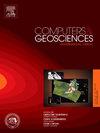Eccentricity curve estimation from geological data using sinusoidal modeling
IF 4.2
2区 地球科学
Q1 COMPUTER SCIENCE, INTERDISCIPLINARY APPLICATIONS
引用次数: 0
Abstract
The estimation of eccentricity curves from geological data is important as it can be used as a basis for the construction of geological timescales, or making inferences of past orbital evolutions of the Solar System. Such estimation can be challenging for multiple reasons like age-depth distortions, non-linear responses to insolation and various other sources of perturbation. We present a novel approach to estimating the eccentricity waveform from geological time series by targeted modifications to the Astronomical Component Estimation model (ACEv.1). We show that analyzing individual precession components is highly beneficial in understanding the impact of perturbation on the estimator. It turns out that individual precession components are fairly stationary in noise-free environments. Although the presence of perturbation modifies the morphology of the corresponding waveforms, the root-mean-square of individual waveforms remains approximately unchanged. This finding allows for a simple adjustment of individual precession components, that renders them almost noise-free. Such an approach provides a high-fidelity precession waveform, from which we can estimate the eccentricity. Furthermore, we provide a benchmark study on both synthetic and real geological data, which assess the performance of the proposed method against three state-of-the-art methods from the literature. The modified ACEv.1 model – here named ACEv.2 – outperforms the reference methods in terms of goodness-of-fit to the known eccentricity solutions in the case of a known age-depth model and precession frequencies. Cyclostratigraphic studies often lack comparisons to other methods; therefore, we believe this study could enhance users' understanding of how the reference methods handle perturbations in geological signals.
求助全文
约1分钟内获得全文
求助全文
来源期刊

Computers & Geosciences
地学-地球科学综合
CiteScore
9.30
自引率
6.80%
发文量
164
审稿时长
3.4 months
期刊介绍:
Computers & Geosciences publishes high impact, original research at the interface between Computer Sciences and Geosciences. Publications should apply modern computer science paradigms, whether computational or informatics-based, to address problems in the geosciences.
 求助内容:
求助内容: 应助结果提醒方式:
应助结果提醒方式:


